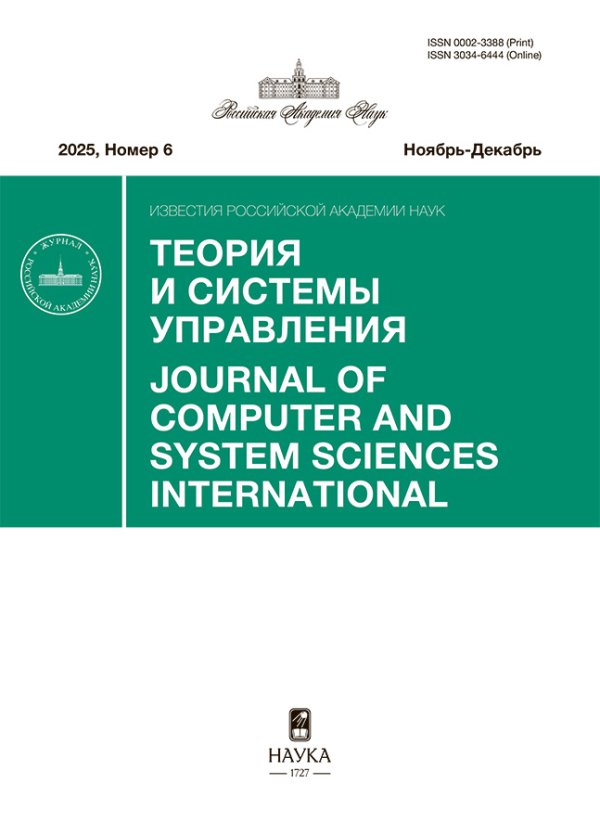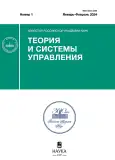No 1 (2024)
STABILITY
On partial stability in probability for nonlinear stochastic functional differential systems with aftereffect (delay)
Abstract
A system of nonlinear functional-differential equations with aftereffect (delay) subjected to random processes of “white” noise is considered. It is assumed that the system admits a “partial” (with respect to some part of the state variables) zero equilibrium position. The problem of stability in probability of a given equilibrium position is posed, and stability is considered not in all, but with respect to a part of the variables that determine this equilibrium position. For the solution of this problem, a stochastic version of the method of Lyapunov—Krasovskii functionals is used with the appropriated specification of the requirements for the functionals. In order to expend the capabilities of the method used, it is also proposed to correct the domain of the functional space in which auxiliary Lyapunov—Krasovskii functionals are constructed. Conditions for partial stability of this type are obtained. Examples are given that show the features of the proposed approach.
 3-16
3-16


CONTROL IN DETERMINISTIC SYSTEMS
Aggregation of multidimensional conservative systems with oscillations
Abstract
We consider the set of multidimensional conservative systems that admits a family of single-frequency oscillations when taken as a unified system. The problem of aggregation of a set of systems into a coupled system with an attractive cycle close to the oscillation of uncoupled systems is solved. Weak universal coupling controls are applied. Previously, the problem was solved for identical reversible one degree of freedom systems.
 17-21
17-21


INFORMATION PROCESSING AND IDENTIFICATION
Stochastic models for time complexity of computing tasks: I. Development principles, statistical data mining, identification problems
Abstract
The paper contains the first part of an investigation devoted to the design of the mathematical models for the execution time of user tasks carried out on the virtual calculating nodes. We suppose that the execution time is a random value with the mean and variance depending on the node resources, task parameters, and the current characteristics of the node state. We discover the key features of the mean and variance functions and specify some of their particular cases. Both the mean and variance functions depend on the unknown parameters, and the design of the stochastic model for the time complexity leads to the parameter identification in the form of the generalized maximum likelihood estimates under the heterogeneous statistical information. The paper also contains recommendations concerning the gathering and subsequent usage of this information: the node testbed preparation, stress test planning, and the obtained data processing. The specific illustrating examples of the proposed mathematical model will be presented in the subsequent parts of the investigation.
 22-34
22-34


MANAGEMENT IN STOCHASTIC SYSTEMS AND UNDER CONDITIONS OF UNCERTAINTY
Optimal finite-dimensional controller of the stochastic differential object’s state by its output II. Stochastic measurements and separation theorem
Abstract
Consideration is continued of the problem of the inertial control law by the output synthesis of a continuous nonlinear stochastic plant, which is optimal on average and on a finite time interval, and works with the desired speed. An algorithm for synthesizing the optimal structure of a dynamic controller of a selected finite order, obtained in the first part of the article for the case of accurate measurements of a of the control object’s state variables part, is presented. Its application is demonstrated in detail for the case when the state variables of an object are measured with random errors. Using the example of a linear-quadratic-Gaussian problem, it is shown that the proposed controller of the corresponding order also satisfies the well-known separation theorem.
 35-51
35-51


OPTIMAL MANAGEMENT
Amplitude control of systems oscillations with friction
Abstract
The method of searching for optimal control of the amplitude of one-dimensional oscillations in the vicinity of the equilibrium position is generalized to the case of a scleronomous multidimensional mechanical system with friction. The oscillatory degree of freedom of the system does not lend itself to direct control. Its movement is influenced by other, directly controlled degrees of freedom, the coordinates of which are selected as control functions. The number of control functions can include both positional and cyclic coordinates. The method does not use conjugate variables in the sense of the Pontryagin’s maximum principle and does not increase the dimension of the original system of differential equations of motion. Using examples of specific oscillatory mechanical models about a pendulum with a support sliding along a cycloid with dry and viscous friction, and about the rescue of a six-legged robot from an emergency position “upside down”, the effectiveness of the proposed method is demonstrated.
 52-73
52-73


Reserching performance of the Dubins machine hybrid model with single separation of control objects
Abstract
The problem of the performance of a hybrid system, which the number of control objects changes during the operation is considered. One control object (carrier) begins to move. At some point in time, several moving objects are separated from it and sent to specified terminal states (targets). The carrier is represented by a hybrid model of the Dubins machine, allowing trajectories of unlimited curvature. The movement of separated objects is rectilinear with limited speeds and accelerations. The problem of minimizing the time to achieve all goals is solved.
 74-90
74-90


MANAGEMENT OF SYSTEMS WITH DISTRIBUTED PARAMETERS
Minimization of integral quadratic estimate of controlled variable in systems with distributed parameters
Abstract
A constructive method for solving the linear-quadratic problem of optimal control of a parabolic-type system with distributed parameters is proposed under the condition of uniform estimation of target sets. The optimality criterion takes the form of an integral quadratic estimate of the controlled state function in the spatio-temporal domain of its definition. A parameterized representation of control inputs is given with the required accuracy within special intervals of the optimal process, where control inputs cannot be determined using first-order analytical optimality conditions. The suggested approach is based on a previously developed alternance method for constructing parameterized algorithms of programmed control, which heavily relies on fundamental regularities of the subject area. It is demonstrated that the equations of the optimal regulators within the special intervals are reduced to the linear feedback algorithms based on the measured states of the objects. These algorithms are supplemented with switches at boundary points to apply admissible control inputs corresponding to the calculated values of the controlled variable.
 91-106
91-106


SYSTEM ANALYSIS AND OPERATIONS RESEARCH
Interval estimation in discrete-time linear systems with parametric uncertainties
Abstract
The problem of interval observer design for discrete-time linear systems under the external disturbances, measurement noise, and parametric uncertainties is studied. The relation allowing designing the interval observer of minimal dimension estimating the set of admissible values of the specified linear vector function of the system state are derived. Theoretical results are illustrated by the example.
 139-149
139-149


COMPUTER METHODS
Interpretability of learning in a signal processing system
Abstract
The paper presents a software package that allows one to generate algorithms for automatic classification of signals. The software package includes an algorithm that converts records of continuous signals into vector form, a set of machine learning methods, as well as data mining tools aimed at achieving transparency and interpretability of learning. The approach is based on the presentation of differences between compared classes as a set of relatively simple, statistically significant and interpretable effects, which are graphically represented on two-dimensional diagrams. The performance of the method is illustrated on the problem of assessing the state of the hive by sound signals. The software package can be used in solving applied problems of automatic diagnostics and data analysis.
 107-121
107-121


Scheduling calculations for a multiprocessor system in real time
Abstract
The problem of scheduling computations in a multiprocessor system is considered for the case when, at some time instants, requests for the execution of job packages with known characteristics are received. Interrupts and switching from one processor to another are allowed. In the first formulation, the composition of all complexes and the characteristics of tasks are known in advance. In the second setting, this information becomes known only at the time of each request. It is required to determine whether there is an admissible schedule for the total set of jobs and build it in case of a positive answer. A setting is studied in which, in addition to processors, there is a non-renewable resource. A polynomial algorithm for solving the problem is developed, based on the construction of a network flow model and the search for the maximum flow.
 122-130
122-130


МАТЕМАТИЧЕСКОЕ МОДЕЛИРОВАНИЕ
Modeling of the dynamics of a catamaran driven by a Savonius rotor and a propeller
Abstract
The dynamics of a catamaran with a Savonius rotor and a propeller installed on it is considered. Under the action of a stationary wind flow the rotor rotates and transmit it to the the propeller, which creates thrust. As a control, the angle of the catamaran’s course relative to the wind flow is considered. The control task is to move the center of the masses of the hull from the starting point to a given endpoint located strictly upstream of the wind. The possibility of straight motion against the wind is shown. The dependence of the averege velocity in the stationary mode of movement against the wind on the radii of the Savonius rotor and propeller is analyzed.
 131-138
131-138


ARTIFICIAL INTELLIGENCE
Explainable artificial intelligence in deep learning neural nets-based digital images analysis
Abstract
This review shows the capabilities of artificial intelligence in the analysis of digital images in the field of medicine using convolutional neural networks of deep learning. A new generation of artificial intelligence systems is described with an explanation of decision-making algorithms to the user — explainable artificial intelligence (XAI). The taxonomy of the methods of explanation and the description of the methods themselves are given. The substantiation of the need to use explainable artificial intelligence in classification tasks is given on the example of ophthalmic diseases. The study of the components of deep learning methods used in the reviewed works (neural network architecture, accuracy, characteristics of data sets) and explainable artificial intelligence (methods of explanation, criteria for the accuracy of explanation). As an example, the problem of recognizing two of the most commonly diagnosed eye diseases: diabetic retinopathy and glaucoma by artificial neural networks is considered.
 150-178
150-178












